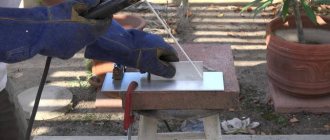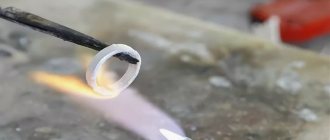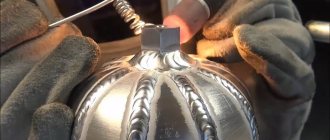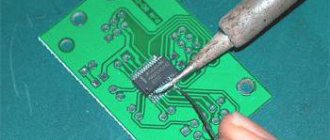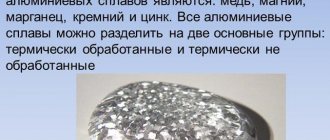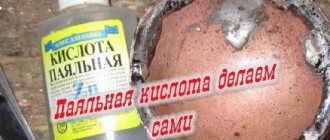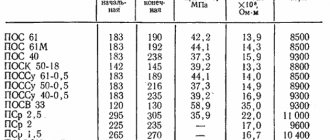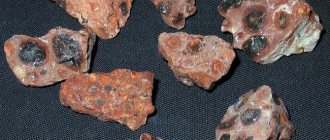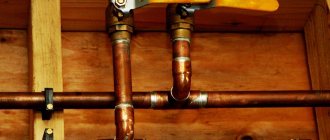Soldering two wires is always better than simply twisting them - such a connection is tight, it never sparks, and therefore does not heat up and does not burn out. Copper is the best solder - it can be easily tinned and the solder sticks to this non-ferrous metal without any problems. That is why copper wires are used in the circuits of any equipment. But there are situations when soldering copper with aluminum is necessary - usually in situations where the house has old aluminum wiring and you need to install a new socket or lamp.
Why is aluminum difficult to solder?
Many people have tried to solder aluminum at home and understand well: the solder does not want to stick to the surface of the parts. This occurs due to the formation of a stable oxide film on the metal, which has low adhesion to the solder material. Methods for soldering aluminum at home come down to fighting the protective film.
In mineralogy, aluminum oxide is called corundum. It consists of transparent crystals, which are gemstones. Corundum has different colors depending on the impurities: chromium gives a reddish tint, sapphire gives a bluish tint. The oxide film is highly durable and cannot be soldered. It must be removed from the surface and then begin to solder the parts.
How to remove oxide film
The film is removed from the metal surface in several ways, the most effective being chemical and mechanical. Both methods require an airless environment in which there is no oxygen to work.
The chemical method is based on the deposition of zinc or copper on the surface of the workpiece by electrolysis. Copper sulfate in the form of a concentrated solution is applied to the area prepared for soldering. The negative terminal of a battery or other power source is attached to a clean area of metal. One end of the copper wire is connected to the positive terminal, the other is dipped into a solution on the surface of the aluminum. As a result of electrolysis, copper or zinc is deposited in a thin layer on the aluminum and adheres tightly to it. Now you can solder aluminum with tin.
An oil film is used to remove the oxide. For this method, it is better to use synthetic or transformer oil with a low water content. Other types of oils need to be kept at a temperature of +150...+200°C, the water will evaporate. At higher temperatures, the contents will begin to splatter. Dehydrated oil is applied to the surface of the aluminum part. Use sandpaper to rub the aluminum under the applied layer to remove the oxide.
The emery cloth is replaced with a scalpel, a serrated soldering iron tip, or iron filings obtained from a nail rubbed with a file. The shavings are poured onto the oil and the soldering iron tip is rubbed over the surface, removing the oxide layer. It is advisable to heat a massive part with a hot air stream. The solder is dipped into the oil droplet with a soldering iron and rubbed over the soldering area. To improve the soldering process, rosin or other flux is added.
How to choose the right flux
When you start choosing a flux, there are a couple of points to consider. First you need to understand what you are working with, because there may be other metal in the welding.
Then, the composition of the flux, it must contain active components, for example: Li (lithium), K (potassium), ZnCl2 (zinc chloride).
If you think about specific companies, then F64 is a standard flux. It contains elements with high activity, there will be no problems.
If you work with high temperatures, then 34A may be suitable for you, and if with low temperatures, then F61, it is sometimes called F61A.
If you solder aluminum and copper, then you can use Castolin 192 CW; its high-quality work has been proven by many positive reviews.
Fluxes for aluminum soldering
Fluxes are highly active, so after soldering they need to be washed off with a solution of water and alkali. Baking soda works well as an alkali. After the alkali, the joint is washed with clean water. Respiratory organs should be protected from flux vapors entering them. They can irritate mucous membranes and enter the blood. The most common of them need to be considered each separately.
Rosin
Rosin is the most popular of all fluxes. It is used in joining various metals. It works on aluminum only in the absence of air, so it is rarely used. More time is spent when working with rosin, but less efficiency. This flux is not for professionals; it can perform soldering, but the quality of the connection is not strong.
Powder flux
Aluminum is soldered with a gas torch using powder fluxes. It is not recommended to add oxygen to the flame; it reduces the efficiency of the flux. The most common fluxes:
- F-34A;
- borax;
- acetylsalicylic acid;
- solder fat.
F-34A is an active flux containing 50% potassium chloride, 32% lithium chloride, 10% sodium fluoride and 8% zinc chloride. The composition is used with solders containing chemical additives. It is hygroscopic and dissolves in water.
Borax is a powder that melts at 700°C, is soluble in water, and can be washed off with an aqueous solution of citric acid. It is characterized by low cost.
Acetylsalicylic acid is found in the form of aspirin tablets. When heated by a soldering iron, vapors that are harmful to human health are released, burning the nose, eyes and respiratory organs.
Solder fat consists of paraffin, ammonium and zinc chloride, and deionized water. Solders well preheated areas that have undergone tinning procedure. After soldering aluminum parts, it is recommended to wash off the remaining flux, otherwise it will cause corrosion of the metal.
Liquid flux
Liquid flux is applied to the soldering area in a thin layer. When working with a soldering iron, it evaporates quickly, releasing scalding fumes. Flux F-64 contains fluorides, tetraethylammonium, corrosion inhibitors and ionized water. It destroys the oxide film well and helps to solder large aluminum workpieces. Used for soldering copper, aluminum, galvanized iron and other metals.
F-61 consists of triethanolamine, ammonium fluoroborate and zinc fluoroborate. Used for tinning and soldering aluminum alloys at temperatures up to 250°C. Castolin Alutin 51 L consists of cadmium, lead and 32% tin. Works most effectively at temperatures above 160°C.
Features of the substance
Active flux for soldering aluminum has significant differences from similar substances used to join products made of steel, brass and copper, just as the properties of these metals themselves differ. The flux composition contains substances that can easily dissolve the oxide film on the surface of aluminum. For soldering aluminum products, fluxes of various numbers are used.
The simplest are fluxes No. 8 and 9, however, their activity is not too great compared to those that include fluorine compounds. The choice is made based on the characteristics of a particular job. There are fluxes that are used for welding joints of parts without prior preparation. The most common type of flux is F-64.
The composition of the flux for aluminum soldering, number F-64, contributes to its increased activity, which makes it possible to successfully clean even uncleaned surfaces from the oxide film. The solution is colorless or light yellow.
Solder for soldering aluminum
Solder for soldering aluminum is made from zinc or aluminum. Additives are added to it to achieve various characteristics: to lower the melting point and increase strength. They are produced in America, Germany, France, Russia. Let's look at some of them.
A common and widely advertised solder for aluminum is HTS 2000. It is produced by a company from the USA. Practice shows its fragility: soldered parts allow air and moisture to pass through. It cannot be used without flux.
Castolin 192FBK based on zinc (97%) and aluminum (2%) is produced in France. The Castolin company produces solders 1827 and AluFlam-190, intended for soldering copper and aluminum at 280°C.
Castolin 192FBK is a tubular solder containing flux in the core. It is produced in the form of rods, 100 g of which costs 100-150 rubles. Solders small holes and cracks well.
Chemet Aluminum 13 is a solder used when welding parts at 640°C and above. It is based on aluminum (87%) and silicon (13%). The melting point of solder is about 600°C. It is produced in the form of rods, of which there are 25 pieces per 100 g. 100 g cost 500 rubles. The variety called Chemet Aluminum 13-UF has a hollow structure and contains flux in the core. Its cost for 12 rods, which weigh 100 g, is 700 rubles.
Aluminum solder is also produced at domestic enterprises. For soldering using a gas torch, grade 34A is used. It melts at a temperature of 525°C and solders AMts, AM3M, AMg2 alloys well. 100 g cost 700 rubles.
Grade A consists of 60% zinc, 36% tin and 2% copper. Melts at 425°C. Produced in rods weighing 145 g. The cost of one rod is 400 rubles.
SUPER A+ is produced in Novosibirsk and is an analogue of HTS-2000. Used together with SUPER FA flux. Costs 800 rubles. per 100 g. In the molten state it becomes viscous, you have to use steel tools to level it.
Aluminum soldering torches
You need to know how to solder with a gas torch. If the area of the parts is large and there is not enough soldering iron power, use a torch. It is better to use a gas one, since soldering aluminum with a gas torch has great capabilities. The burner quickly heats the joint of the parts almost to the melting temperature of aluminum. Flux with solder is applied to the joint, leveled with a soldering iron tip and hardened. The joint must be washed to remove any remaining soldering acid or other flux.
When working with burners, you must follow fire safety rules. There should be no flammable liquids or materials nearby.
Nuances
Before work, you need to prepare the metal to interact with the flux. Without preparation there is no point in working further. It doesn't matter what you use - flux, resistance welding or gas - preparation is very important.
In order to degrease aluminum, you need a lint-free cloth and a solvent. To clean the metal before soldering, you need to prepare tools: grinder, sandpaper, grinder.
If you use a grinder, then also use abrasive wheels and replaceable metal brushes. We advise you to sometimes change cleaning options, depending on how dirty the metal is.
If the metal is very dirty, then the etching method can be used. You need to take a container, pour acid solutions into it and lower the part into it until it is completely clean.
After cleaning, the film will disappear, this will not last long. As far as you are aware, it can recover if it is exposed to oxygen.
You may ask, why clean the metal if the film is renewed anyway? Yes, because after cleaning it weakens and loses half its chemical activity. And the flux works better on a cleaned shell, which makes welding much easier.

